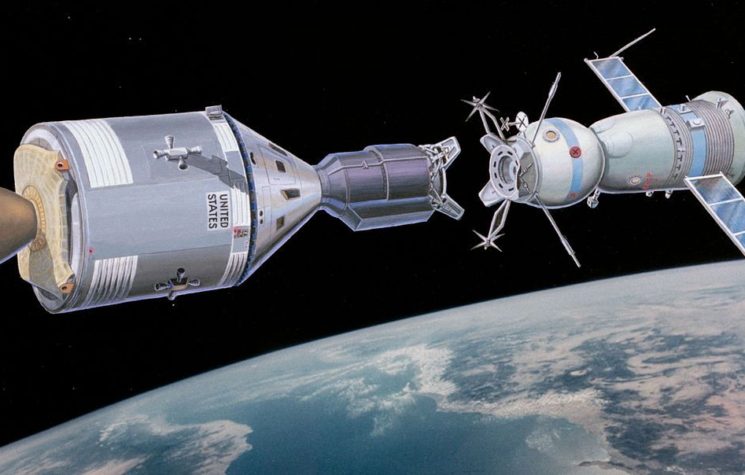Whatever forces are behind the current spread of the coronavirus justifying the shutdown of major nations across the globe, one thing is increasingly certain: a new system will absolutely emerge from the currently collapsing one. What remains to be seen is whether this new system will be shaped by those fascist crisis-loving technocrats pushing for a unipolar world order, or whether it will be organized by sovereign nation states working together under a multi -polar community of principle.
Amidst the confusion and fear driven by the global pandemic, President Trump passed a fascinating Executive Order on April 6 calling for the mining of asteroids and the Moon which may serve as the gateway to shaping a new system of economic relations, rules and values around a shared future for humankind. Trump’s Executive Order states in part that “successful long term exploration and scientific discoveries of the Moon, Mars and other celestial bodies will require partnerships with commercial entities to recover and use resources, including water and certain minerals in outer space.”
In stark opposition to those cynics who wish to analyse every event from the lens of simple geopolitics, the executive order goes onto reject unilateralism in space (promoted by the Space Force ideologues seeking to extend militarisation beyond earth) and rather calls for cooperation, stating that the USA “shall seek to negotiate joint statements, and bilateral and multilateral arrangements with foreign states regarding safe and sustainable operations for the public and private recovery and use of space resources.”
This potential for a shared future for global (and celestial) development stands in stark opposition to certain forces who would rather use the two-fold crisis of economic collapse and viral pandemics to usher in a new age of fascism and world government under a Global Green New Deal. As I wrote in an earlier paper, this clash is exemplified by the closed system thinking of Malthusians and neocons vs. the open system thinking of genuine patriots and world citizens.
How the Dream of Open System Economics Was Lost
It was once believed in the west that the future would be beautiful, just, and as plentiful as it was peaceful. Under John F. Kennedy’s bold leadership the idea of space exploration was more than a simple “space race” or plopping a human being on the moon “within the decade and returning him safely back home”. Far from this narrow view, JFK and many leading American scientists saw this goal as a springboard to a new age of creative growth for all humanity both on the Moon and beyond. These stirring forecasts of an age of reason can still be heard in recordings of Kennedy’s Rice University address of September 12, 1962.
Unbeknownst to many, JFK also called for a USA-Russia joint Moon landing in order to defuse the Cold War formula of MAD and had this plan not been derailed, the world would have found itself on a much different trajectory.
Unfortunately, history unfolded on a different course. After JFK’s murder (weeks after the above speech), his program to remove troops from Vietnam was reversed and the USA was plunged into the disastrous Vietnam war for over a decade. As the war grew, federal funds needed for science and exploration were increasingly absorbed by the military industrial complex.
By 1972, the last human mission on the Moon took place and by 1976, Russia’s last lunar project also occurred with Luna 6. Although small efforts to keep the dream alive continued in piecemeal form over the years, Apollo was scrapped and national support for long-term objectives slowly decayed and a generation of space scientists and engineers found themselves disillusioned by decades of broken promises and a lost dream. Russian scientists suffering the debilitating effects of Perestroika shared in this dismal experience and found themselves unemployed throughout the 1990s and in many cases forced to use their powerful mathematical skills in the financial services sector of London in order to make ends meet (giving rise to the age of quants and speculative high frequency derivatives trading).
During this period of disenchantment, China arose silently under the radar patiently building its capacities from scratch.
The Rise of China’s Space Program
Although its first satellite launch took place during the height of the Cultural Revolution in 1970, the Chinese space program grew much more slowly than its counterparts in Russia or the USA. Patiently learning from the best engineering feats of the west, under the wise guidance of Deng Xiaoping, China finally became the third nation to successfully send a human into orbit in 2003 and one decade later, became the first nation in 37 years to return to the Moon with the successful landing of the Chang’e-3 rover in December 2013. Lieutenant General Zhang Yulin called this program “the great rejuvenation of the Chinese nation” and the world came to soon see what incredible plans were yet in store for China’s goals in space.
Soon China had launched the Tiangong 1 and 2 (Heavenly Palace) test space stations in preparation for the 2021 launching of the Large Modular Space Station named Tianhe (“Harmony of the Heavens”) which will be a vital platform for the earth-lunar economy for decades.
On January 3, 2019, China set a world milestone by becoming the first nation to successfully land a rover on the far side of the moon with Chang’e 4, which has begun topographical, resource and geological mappings of the lunar surface. Change’e 5, 6, and 7 will continue these explorations while adding the feature of returning samples to the earth and preparing the groundwork for a permanent lunar base by 2030. Chang’e-8 will be especially important as it will print the first ever 3D structures on the Moon by 2028.
Unfortunately, due to the Obama-era “Wolf Act” of 2011, American scientists could not participate in these achievements and had to watch from afar as China swiftly leapt to the forefront of space science dethroning America from the unchallenged stature she once enjoyed.
Asteroid Threats
Earlier in 2013, before Chang’e-3 landed on the Moon, another humbling event took place and served as a sort of divine slap in the face for many. This wake up call took the form of a 9000 ton asteroid which exploded 22 km over Chelyabinsk, Russia sending shock waves that shattered windows and injured over 2000 citizens. The Chelyabinsk incident served as a timely reminder that the universe offers enough existential challenges for humanity without the additional man-made calamities of regime change wars and fighting over diminishing returns of resources.
From this Russian incident, NASA’s Planetary Defense Coordination Office was created to begin to establish a plan for asteroid threats from space alongside similar departments in Roscosmos, and the European and Chinese Space Agencies. Ouyang Ziyan (the father of China’s lunar program) stated that asteroid defense “is worth attention while we are devoted to building a community with a shared future for humanity… Scientists around the world should cooperate to monitor near-Earth asteroids.”
In November 2019, Roscosmos Director of Science and Long Term Programs (Alexander Bloshenko) stated that Russia’s lunar development goals which included a base on the underside of the Moon within a decade were intertwined with asteroid defense stating: “There are plans to install equipment on this [lunar] base to study deep space and special telescopes to track asteroids and comets that pose a danger with their collision with earth.”
By Summer 2019, NASA’s administrator Jim Bridenstine also announced his intention for USA-Russian cooperation on asteroid defense- joining the earlier call made by Roscosmos’ head Dimitri Rogozin for a “Strategic Defense of Earth” which Rogozin described as a way to redirect nuclear weapons towards a common threat in space rather than towards each other. This call for cooperation dovetails the two-fold space strategy unveiled by President Trump in December 2017 with Space Policy Directive 1: Reinvigorating America’s Human Space Exploration Program, where he called for 1) The creation of the Lunar Gateway space station to orbit the Moon and 2) the launching of the Artemis Project that will “lead the return of humans to the Moon for long term exploration and utilisation, followed by human missions to Mars and other destinations.”
These developments were punctuated by Trump who took the time from his impeachment fiasco to call for an alliance that too many analysts have chosen to ignore saying on– : “Between Russia, China and us, we’re all making hundreds of billions of dollars worth of weapons, including nuclear, which is ridiculous… I think it’s much better if we all got together and didn’t make these weapons… those three countries I think can come together and stop the spending and spend on things that are more productive toward long term peace.”
Although the COVID-19 lock down has done major damage to the schedule for the Orion capsule and space launch system mega rocket needed to carry out the Artemis Project, the scheduled 2024 landing of a man and woman onto the moon’s surface is still on course.
A Revolution in Mining: Redefining “Resources”
But it doesn’t end there. Leading officials among all three Russian, Chinese and American space agencies have called for going beyond asteroid defense, and colonization with the call for lunar, mars and asteroid resource development strategies. These strategies require that humanity redefine the practice of “mining” as it has hitherto been known for thousands of years, but also re-define what a “resource” is, what “energy” is and what are the limits (if any) to human growth?
A helpful tool to conceptualize this revolution in thinking can be found in the 10 minute video All the World’s A Mine made in 2013:
In carefully mapping the lunar terrain with a focus on the far side of the moon, China wishes to come to a better understanding of the mineral distribution of vital resources like Titanium, Iron, silicon, aluminium, water, oxygen and hydrogen and especially Helium-3 which are abundant on the Lunar regolith. Helium-3, long called the “Philosophers’ Stone” of energy is the most efficient fuel source for fusion power when fused with deuterium or tritium in a plasma and though it is nearly non-existent on the earth exists in vast quantities on the moon due to the absence of a geomagnetic field. As the Moon’s far side never faces the earth or the earth’s magnetic field, there are far more abundant volumes of solar-produced Helium-3 that have accumulated there over millennia.
Ouyang Ziyuan stated clearly that Helium-3 could “solve humanity’s energy demand for 10 000 years at least” since “each year, three space shuttle missions could bring enough fuel for all human beings across the world.”
In 2013, Ziyuan stated “The Moon is full of resources- mainly rare Earth elements, titanium and uranium which the Earth is really short of, and these resources can be used without limitation… There are so many potential developments- it’s beautiful- so we hope we can fully utilize the Moon to support sustainable development for humans and society.”
China’s Premier Li Keqiang added his voice to the mix stating: “China’s manned space and lunar probe missions have a twofold purpose: first, to explore the origin of the universe and mystery of human life; and second, to make peaceful use of outer space… Peaceful use of outer space is conducive to China’s development. China’s manned space program has proceeded to the stage of building a space station and will move forward step by step.”
In September 2019, Russia and China signed a historical agreement to jointly collaborate on lunar development uniting the Chang’e-7 plans with Russia’s Lunar 26 Orbiter and lunar base development which both nations have on the agenda for 2030-2035.
A Word on the Moon Treaty of 1979
Donald Trump’s explicit rejection of the Moon Treaty of 1979 in his recent executive order, has garnered many angry criticisms which on closer inspection are completely unfounded. The 1979 Treaty requiring that all commercial activities in space must be defined by an international framework appears on the surface to be quite sensible. So is Trump’s rejection of any obedience to an “international framework” at this moment in history evidence of his selfish-nationalistic impulses to impose gangster capitalism onto the whole universe? Not at all.
As stated at the beginning of this report, President Trump’s order calls explicitly for “encouraging international support for the recovery and use of space resources” which is in no way characteristic of “narrow minded selfish nationalism” or “unilateral militarism” extolled by the many neocon ideologues struggling to take control of U.S. Space policy. Also when one considers that only 4 nations ratified that 1979 treaty (France, Guatemala, India and Romania), Trump’s refusal to obey it is not nearly as renegade and selfish as those critics make it appear.
Finally, when one considers who would define that “international framework” and considers the zero-growth paradigm currently dominant across the UN and European Union technocracy, then it quickly becomes clear that the Green New Deal agenda for shutting down industrial civilization is totally incompatible with the pro-growth, pro-space mining orientation of Russia, China and Trump’s USA alike.















































